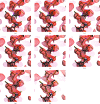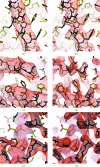Automated map sharpening by maximization of detail and connectivity
- PMID: 29872005
- PMCID: PMC6096490
- DOI: 10.1107/S2059798318004655
Automated map sharpening by maximization of detail and connectivity
Abstract
An algorithm for automatic map sharpening is presented that is based on optimization of the detail and connectivity of the sharpened map. The detail in the map is reflected in the surface area of an iso-contour surface that contains a fixed fraction of the volume of the map, where a map with high level of detail has a high surface area. The connectivity of the sharpened map is reflected in the number of connected regions defined by the same iso-contour surfaces, where a map with high connectivity has a small number of connected regions. By combining these two measures in a metric termed the `adjusted surface area', map quality can be evaluated in an automated fashion. This metric was used to choose optimal map-sharpening parameters without reference to a model or other interpretations of the map. Map sharpening by optimization of the adjusted surface area can be carried out for a map as a whole or it can be carried out locally, yielding a locally sharpened map. To evaluate the performance of various approaches, a simple metric based on map-model correlation that can reproduce visual choices of optimally sharpened maps was used. The map-model correlation is calculated using a model with B factors (atomic displacement factors; ADPs) set to zero. This model-based metric was used to evaluate map sharpening and to evaluate map-sharpening approaches, and it was found that optimization of the adjusted surface area can be an effective tool for map sharpening.
Keywords: X-ray crystallography; cryo-electron microscopy; map interpretation; map sharpening.
open access.
Figures











References
-
- Adams, P. D. et al. (2010). Acta Cryst. D66, 213–221. - PubMed
-
- Afonine, P. V., Poon, B. K., Read, R. J., Sobolev, O. V., Terwilliger, T. C., Urzhumtsev, A. & Adams, P. D. (2018). bioRxiv, 249607. https://doi.org/10.1101/249607.
Publication types
MeSH terms
Substances
Grants and funding
LinkOut - more resources
Full Text Sources
Other Literature Sources

